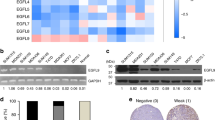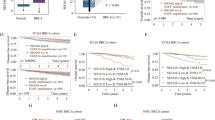Abstract
ErbB2 is overexpressed in approximately 25% of breast cancer cases and promotes metastatic potential. We previously reported that ErbB2 promoted glycolysis via heat shock factor 1 (HSF1)/lactate dehydrogenase A (LDHA) axis and ErbB2-mediated glycolysis was required for the growth of breast cancer cells. However, the importance of HSF1/LDHA axis-mediated glycolysis in ErbB2-enhanced metastatic potential remains to be elucidated. In this study, we investigated the effect of HSF1/LDHA axis-mediated glycolysis on migration and invasion in breast cancer cells. Firstly, we demonstrated that ErbB2-mediated migration and invasion were dependent on glycolysis in breast cancer cells. Secondly, we found that HSF1/LDHA axis played an important role in glycolysis, which contributed to ErbB2-enhanced migration and invasion. Finally, we showed that ErbB2 was positively correlated with HSF1/LDHA axis in invasive breast cancer patients via GEO analysis. Taken together, ErbB2 promoted metastatic potential of breast cancer cells via HSF1/LDHA axis-mediated glycolysis. And our findings indicated that targeting HSF1/LDHA axis may be a promising strategy to treat ErbB2-overexpressing breast cancer patients.






Similar content being viewed by others
References
Warburg O. On the origin of cancer cells. Science. 1956;123:309–14.
Lunt SY, Vander Heiden MG. Aerobic glycolysis: meeting the metabolic requirements of cell proliferation. Annu Rev Cell Dev Biol. 2011;27:441–64.
Hirschhaeuser F, Sattler UG, Mueller-Klieser W. Lactate: a metabolic key player in cancer. Cancer Res. 2011;71:6921–5.
San-Millan I, Brooks GA. Reexamining cancer metabolism: lactate production for carcinogenesis could be the purpose and explanation of the Warburg effect. Carcinogenesis. 2017;38:119–33.
Slamon DJ, Godolphin W, Jones LA, Holt JA, Wong SG, et al. Studies of the HER-2/neu proto-oncogene in human breast and ovarian cancer. Science. 1989;244:707–12.
Weigelt B, Peterse JL, van't Veer LJ. Breast cancer metastasis: markers and models. Nat Rev Cancer. 2005;5:591–602.
Zhao YH, Zhou M, Liu H, Ding Y, Khong HT, et al. Upregulation of lactate dehydrogenase A by ErbB2 through heat shock factor 1 promotes breast cancer cell glycolysis and growth. Oncogene. 2009;28:3689–701.
Zhou L, Jiang S, Fu Q, Smith K, Tu K, et al. FASN, ErbB2-mediated glycolysis is required for breast cancer cell migration. Oncol Rep. 2016;35:2715–22.
Dai C, Whitesell L, Rogers AB, Lindquist S. Heat shock factor 1 is a powerful multifaceted modifier of carcinogenesis. Cell. 2007;130:1005–18.
Gomez-Pastor R, Burchfiel ET, Thiele DJ. Regulation of heat shock transcription factors and their roles in physiology and disease. Nat Rev Mol Cell Biol. 2018;19:4–19.
Jiang S, Tu K, Fu Q, Schmitt DC, Zhou L, et al. Multifaceted roles of HSF1 in cancer. Tumour Biol. 2015;36:4923–31.
Carpenter RL, Paw I, Dewhirst MW, Lo HW. Akt phosphorylates and activates HSF-1 independent of heat shock, leading to Slug overexpression and epithelial-mesenchymal transition (EMT) of HER2-overexpressing breast cancer cells. Oncogene. 2015;34:546–57.
Fang F, Chang R, Yang L. Heat shock factor 1 promotes invasion and metastasis of hepatocellular carcinoma in vitro and in vivo. Cancer. 2012;118:1782–94.
Gokmen-Polar Y, Badve S. Upregulation of HSF1 in estrogen receptor positive breast cancer. Oncotarget. 2016;7:84239–45.
Nakamura Y, Fujimoto M, Fukushima S, Nakamura A, Hayashida N, et al. Heat shock factor 1 is required for migration and invasion of human melanoma in vitro and in vivo. Cancer Lett. 2014;354:329–35.
Santagata S, Hu R, Lin NU, Mendillo ML, Collins LC, et al. High levels of nuclear heat-shock factor 1 (HSF1) are associated with poor prognosis in breast cancer. Proc Natl Acad Sci USA. 2011;108:18378–83.
Xi C, Hu Y, Buckhaults P, Moskophidis D, Mivechi NF. Heat shock factor Hsf1 cooperates with ErbB2 (Her2/Neu) protein to promote mammary tumorigenesis and metastasis. J Biol Chem. 2012;287:35646–57.
Augoff K, Hryniewicz-Jankowska A, Tabola R. Lactate dehydrogenase 5: an old friend and a new hope in the war on cancer. Cancer Lett. 2015;358:1–7.
Miao P, Sheng S, Sun X, Liu J, Huang G. Lactate dehydrogenase A in cancer: a promising target for diagnosis and therapy. IUBMB Life. 2013;65:904–10.
Girgis H, Masui O, White NM, Scorilas A, Rotondo F, et al. Lactate dehydrogenase A is a potential prognostic marker in clear cell renal cell carcinoma. Mol Cancer. 2014;13:101.
Rong Y, Wu W, Ni X, Kuang T, Jin D, et al. Lactate dehydrogenase A is overexpressed in pancreatic cancer and promotes the growth of pancreatic cancer cells. Tumour Biol. 2013;34:1523–30.
Xian ZY, Liu JM, Chen QK, Chen HZ, Ye CJ, et al. Inhibition of LDHA suppresses tumor progression in prostate cancer. Tumour Biol. 2015;36:8093–100.
Xiao X, Huang X, Ye F, Chen B, Song C, et al. The miR-34a-LDHA axis regulates glucose metabolism and tumor growth in breast cancer. Sci Rep. 2016;6:21735.
Fantin VR, St-Pierre J, Leder P. Attenuation of LDH-A expression uncovers a link between glycolysis, mitochondrial physiology, and tumor maintenance. Cancer Cell. 2006;9:425–34.
Gao S, Tu DN, Li H, Jiang JX, Cao X, et al. Pharmacological or genetic inhibition of LDHA reverses tumor progression of pediatric osteosarcoma. Biomed Pharmacother. 2016;81:388–93.
Jiang F, Ma S, Xue Y, Hou J, Zhang Y. LDH-A promotes malignant progression via activation of epithelial-to-mesenchymal transition and conferring stemness in muscle-invasive bladder cancer. Biochem Biophys Res Commun. 2016;469:985–92.
Jin L, Chun J, Pan C, Alesi GN, Li D, et al. Phosphorylation-mediated activation of LDHA promotes cancer cell invasion and tumour metastasis. Oncogene. 2017;36:3797–806.
Rizwan A, Serganova I, Khanin R, Karabeber H, Ni X, et al. Relationships between LDH-A, lactate, and metastases in 4T1 breast tumors. Clin Cancer Res. 2013;19:5158–69.
Yuan G, Qian L, Shi M, Lu F, Li D, et al. HER2-dependent MMP-7 expression is mediated by activated STAT3. Cell Signal. 2008;20:1284–91.
Zhang R, Su J, Xue SL, Yang H, Ju LL, et al. HPV E6/p53 mediated down-regulation of miR-34a inhibits Warburg effect through targeting LDHA in cervical cancer. Am J Cancer Res. 2016;6:312–20.
Appert-Collin A, Hubert P, Cremel G, Bennasroune A. Role of ErbB receptors in cancer cell migration and invasion. Front Pharmacol. 2015;6:283.
Jeon M, Lee J, Nam SJ, Shin I, Lee JE, et al. Induction of fibronectin by HER2 overexpression triggers adhesion and invasion of breast cancer cells. Exp Cell Res. 2015;333:116–26.
Sotiriou C, Wirapati P, Loi S, Harris A, Fox S, et al. Gene expression profiling in breast cancer: understanding the molecular basis of histologic grade to improve prognosis. J Natl Cancer Inst. 2006;98:262–72.
Toma-Jonik A, Widlak W, Korfanty J, Cichon T, Smolarczyk R, et al. Active heat shock transcription factor 1 supports migration of the melanoma cells via vinculin down-regulation. Cell Signal. 2015;27:394–401.
Faubert B, Li KY, Cai L, Hensley CT, Kim J, et al. Lactate metabolism in human lung tumors. Cell. 2017;171:358–71.
Hui S, Ghergurovich JM, Morscher RJ, Jang C, Teng X, et al. Glucose feeds the TCA cycle via circulating lactate. Nature. 2017;551:115–8.
Brand A, Singer K, Koehl GE, Kolitzus M, Schoenhammer G, et al. LDHA-associated lactic acid production blunts tumor immunosurveillance by T and NK Cells. Cell Metab. 2016;24:657–71.
Baumann F, Leukel P, Doerfelt A, Beier CP, Dettmer K, et al. Lactate promotes glioma migration by TGF-beta2-dependent regulation of matrix metalloproteinase-2. Neuro Oncol. 2009;11:368–80.
Stern R, Shuster S, Neudecker BA, Formby B. Lactate stimulates fibroblast expression of hyaluronan and CD44: the Warburg effect revisited. Exp Cell Res. 2002;276:24–31.
Ji Y, Yang C, Tang Z, Yang Y, Tian Y, et al. Adenylate kinase hCINAP determines self-renewal of colorectal cancer stem cells by facilitating LDHA phosphorylation. Nat Commun. 2017;8:15308.
Acknowledgements
We thank Prof. Ming Shi (Institute of Basic Medical Sciences, Beijing, China) for providing MCF7/ErbB2 cell line. We thank Dr. Guan Wang (State Key Laboratory of Biotherapy, Sichuan University, China) for assistance with GEO analysis. We thank Kelly Smith (Mitchell Cancer Institute, University of South Alabama, USA) for polishing this paper.
Funding
This work was supported by the National Natural Science Foundation of China (Grant No. 81272907).
Author information
Authors and Affiliations
Contributions
Conceptualization: YZ and RY; Methodology: LH, SL, and YZ; Formal analysis and investigation: LH, SL, XM, and SJ; FZ; Writing-original draft preparation: LH; Writing-review and editing: YZ and SL; Funding acquisition: YZ; Resources: YZ; Supervision: YZ and RY. All authors have read and approved the final manuscript.
Corresponding authors
Ethics declarations
Conflict of interest
The authors declare no conflict of interest.
Additional information
Publisher's Note
Springer Nature remains neutral with regard to jurisdictional claims in published maps and institutional affiliations.
Supplementary Information
Below is the link to the electronic supplementary material.
Rights and permissions
About this article
Cite this article
He, L., Lv, S., Ma, X. et al. ErbB2 promotes breast cancer metastatic potential via HSF1/LDHA axis-mediated glycolysis. Med Oncol 39, 45 (2022). https://doi.org/10.1007/s12032-021-01641-4
Received:
Accepted:
Published:
DOI: https://doi.org/10.1007/s12032-021-01641-4




